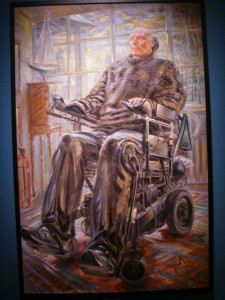
Actor/activist Christopher Reeve shortly before his death in 2004 (by Sacha Newley; photo by Ludmila)
Last Friday in Atlanta, a patient with spinal cord injuries, paralyzed from the waist down, became the first clinical trial subject to receive a treatment derived from embryonic stem cells. Despite widespread misreporting in the media, the patient didn’t receive embryonic stem cells directly — that’s well known to create teratomas. Instead, oligodendrocyte progenitor cells — precursors of the cells that form the insulating sheath around nerve fibers and have nerve growth-stimulating properties — were derived from embryonic stem cells and injected into the site of damage.
With luck, the cells will figure out what to do, the spinal cord will heal, and the patient will regain at least some motor function. Eight to 10 more patients are expected to be treated at sites around the country in a clinical trial sponsored by Geron Corporation.
This is what stem cell researchers have been waiting for — a carefully regulated, science-based trial of a stem-cell-based therapy, in contrast to unproven stem cell “cures” offered by questionable U.S. and offshore clinics. The response from Children’s is one of cautious optimism. “I think we should anticipate many failures before we ultimately see success,” George Daley, MD, PhD, director of the Stem Cell Transplantation Program told ABC News in a Skype interview this week. Read the response from Children’s Stem Cell Program in full here.
Also hear from Barry Siegel, who became quadriplegic after being hit by a motorist while biking, and is supporting a collaboration between Children’s Hospital and Hadassah Hospital in Israel, aimed at developing treatments for spinal cord injuries and other neurological disorders.






